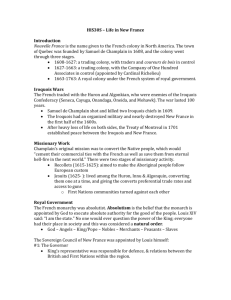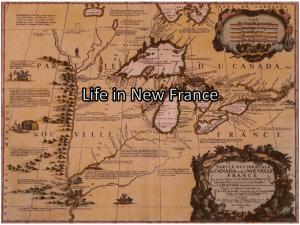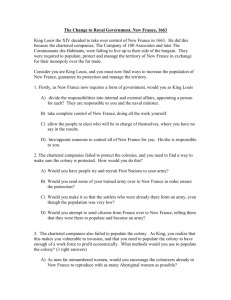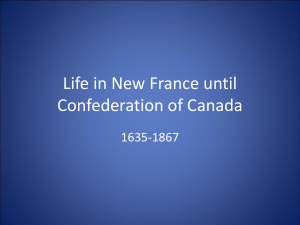Life in New France: Royal Government 1663-1738
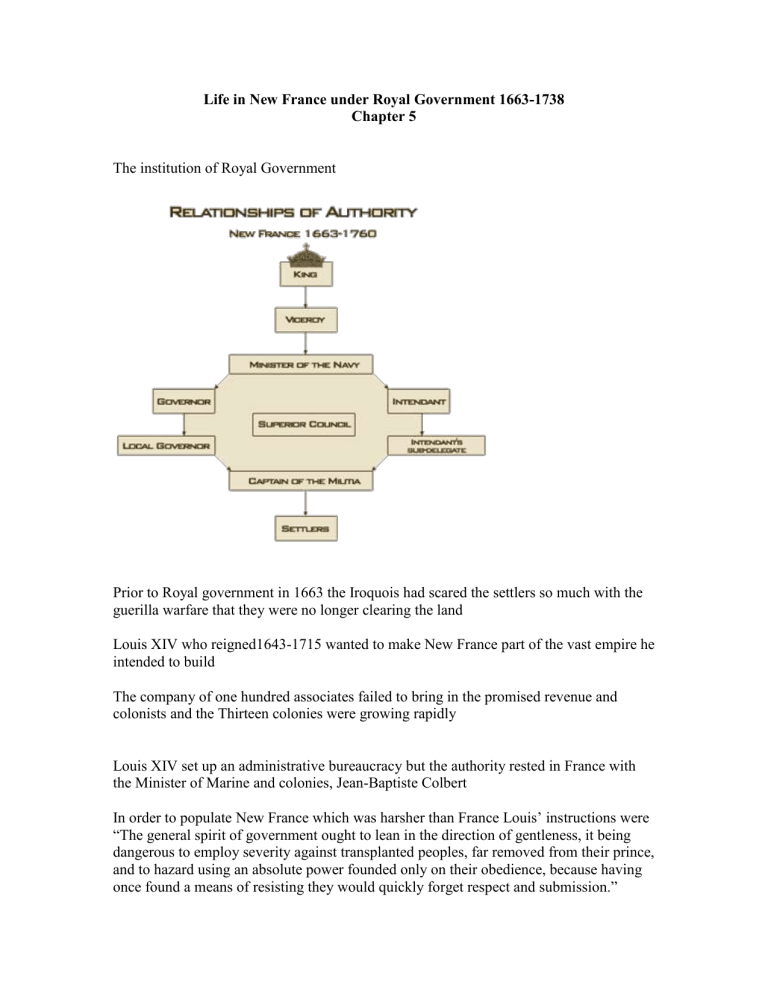
Life in New France under Royal Government 1663-1738
Chapter 5
The institution of Royal Government
Prior to Royal government in 1663 the Iroquois had scared the settlers so much with the guerilla warfare that they were no longer clearing the land
Louis XIV who reigned1643-1715 wanted to make New France part of the vast empire he intended to build
The company of one hundred associates failed to bring in the promised revenue and colonists and the Thirteen colonies were growing rapidly
Louis XIV set up an administrative bureaucracy but the authority rested in France with the Minister of Marine and colonies, Jean-Baptiste Colbert
In order to populate New France which was harsher than France Louis’ instructions were
“The general spirit of government ought to lean in the direction of gentleness, it being dangerous to employ severity against transplanted peoples, far removed from their prince, and to hazard using an absolute power founded only on their obedience, because having once found a means of resisting they would quickly forget respect and submission.”
Jean Talon was the first intendant sent from France after 1663 to have responsibility for the civil administration of justice, police, and finances in the colony
Remy de Courcelle, the first governor had power over military matters and external policy
The Sovereign council which was the highest court in the land consisted of de Courcelle,
Talon, the bishop and five councilors
Initially France was quite involved, but as they were distracted with European wars, New
France began to be run by Canadians
The governors in New France had to act on their own very often due to the time it took to communicate with France
Jean Talon
First he supplied and housed the Carignan-Salieres regiment that had been sent to defend
Quebec and then proceeded to expanding settlement in the colony
1665-1672 1500 people arrived in Canada as settlers or engages (indentured servants)
Talon was successful in increasing the population and diversifying agriculture so that the surplus was sent to France
Talon also established other industries in Quebec: cloth, tanneries, lumber and shipbuilding (did not last)
75% of the American continent came under French control due to Jean Talon and expanding control of the fur trade
Citizenship under Royal Government
The administrators held the authority and were expected to keep order along with the seigneurs and military
The Catholic teachings instructed them to be paternalistic and take care of the colonists as long as they did what they were told
The old traditions did change in Canada.
A commoner could rise to be a seigneur, a military commander or a bishop and the traditions also changed because people from all regions of France were brought together
The Coureur de Bois and Voyageurs were also influenced by the Aboriginal way of life
The Seigneural System
By 1740 there were over 200 seigneuries on both sides of the St. Lawrence River based on the feudal system
In New France, not all Seigneurs were noble and were often not much wealthier than the
Habitants
If they could not inhabit their land he might not be able to build a gristmill which was part of the contract and would lose his land
Many seigneurs got involved in the Fur trade and commercial interests to supplement their income which was different from France
Not many villages either in New France instead the farms were isolated and spread out along the St. Lawrence
Slavery in New France
Slavery was established through a royal mandate in 1689
There were some African slaves, but most were Aboriginal
Royal declarations in 1721, 1742 and 1745 confirmed slavery in New France
They were often domestic servants and unpaid labour
The Aboriginal People under Royal Rule
“Throughout the history of New France, the French policy towards [Aboriginal Peoples] was consistent: treat them with every consideration, avoid violence… and transform them into Frenchmen.” Olive Dickason
The French put up with their different way of life due to the fur trade and for protection from the Iroquois, but they did not give up on assimilating them.
They hoped that by converting them to Catholicism, the hierarchy would make them ready to follow French society
The schools were not a success and trying to impose French laws on the Aboriginals was also met with resistance
Intermarriage backfired, as most often the husband seemed to acclimatize to the
Aboriginal way of life and not the other way around
Missionaries thought intermarriage was okay as long as the women were baptised which they hoped would increase the conversion rate
By 1735 consent was needed for the marriage as the French realized it was not helping with trade or assimilation
Mercantilism
The more gold and silver the better
If one did not have mines, then you needed to trade to acquire gold and silver
More exports than imports = colonies the supplier of raw materials and the market for manufactured goods
Mercantilism stifled the growth of the colony and industry
Mercantilism was good in that it guaranteed France had to buy all the production of the colonies and give financial support to keep the colony running
Merchants in France had to make sure that the colony maintained its supplies of trade goods, arms and ammunition and pay the shipping and insurance for transport
Fur Trade
By the late 17 th
century, beaver was scarce in the St. Lawrence lowlands and French traders began to go further into the upper country
State and church officials were worried about the young men who went off to trade as it took away from agriculture
King Louis XIV instructed governor Fontana to get the Coureur de bois under control by punishment or even imprisonment
Trading brandy for furs was very destructive to the aboriginals, but continued to be used as a trade good due to revenue
The Hudson’s Bay Company got into the fur trade in 1670
Pierre Esprit Radisson and Medard Chouart des Groseilliers had brought the wealth of the furs in the region to the attention of merchants in London.
The English built forts and began to trade with the Cree
The French responded by building a trading post on Lake Nipigon and diverted traders away from Hudson’s Bay
In 1682 they attacked Hudson’s Bay company posts and held them until 1714.
Conges were licensed to trade by the governor and intendant, but this never stopped the
Coureur de Bois from living in the up country and trading in furs
In 1716 new importance was attached to the fur trade
The trading posts and military posted there were given control of the fur trade
Colonization
During 150 years of French rule 30 000 people came from Europe, but only 1/3 stayed to settle in New France.
By 1704 there were 906 000 people living in the English colonies versus 43 000 in New
France
Intendant Talon realized that the King and Colbert were not serious enough about sending settlers, but was concerned with supporting the ones that were already in New
France
Talon and the Church instead encouraged families to have a lot of children
Until 1673 a boy who married at 20 years or younger and a girl who married at 16 years or younger received 20 livres on their wedding day
A yearly 300 livres was given to families with 10 living children and 400 livres to families with 12 or more children
Bachelors by law had to marry filles du roi under penalty of losing their rights to fish, hunt or engage in the fur trade
Until 1700 Canadian women gave birth to an average of 8 or 9 children
Emigrating to New France
Most settlers came from villages in Northern and Western France and originally most were men who came as soldiers, workmen or servants as well as engages
Filles de Roi were sent with a dowry of 50 livres and sent to find husbands in New
France
Many stayed with Marie De L’incarnation and the Ursuline nuns who introduced them to the young men
By 1681, the colony had a population of about 10 000 created most of the Francophone population of Canada
In 1665 the Carignan-Salieres regiment was sent to defend Quebec
They were ill-equipped and prepared to build forts and for the weather
1666 the governor sent them on a disastrous foray into Iroquois territory where 400 men froze to death and they never found the village
In the spring the Iroquois signed a peace treaty after 1300 soldiers, militiamen and
Aboriginal allies burned their villages and destroyed their winter stock of grain
The soldiers were encouraged to settle in Quebec with grants of seigneuries for the officers or land and money for the soldiers
400 members stayed in Canada
The Canadian militia was formalized after 1669 by Louis XIV who stated that all men
16-60 had to belong
The militia was for defence, but had a reputation as ruthless fighters who were feared by their enemies
Many were fur traders who knew the land even in pays haut
Many were hunters who were a good shot and they had learned guerrilla tactics of the
Iroquois
By the end of the 17 th century, each parish had its own militia who trained for a month or two each year
They also helped with the infrastructure in their parishes
The militia were the best fighting force on the North American continent
1690 defeated the British at Schenectady and also defeated the retaliatory fleet of 24 ships sent to Quebec from Boston
Engages were young men who signed a contract for three years
The recruiter advanced part of their wages for the trip over and agreed to pay for the trip back if they decided not to stay in New France
They received room and board and a wage as low as 75 livres a year from which living expenses were deducted (clothing and food)
Between 1664 and 1671 1000 engages arrived in Quebec of which 500 stayed to settle
The Society of New France
In New France most people were married unless belonging to a religious order
In spite of incentives from Talon, the average age for a first marriage was 22 for women and 27 for men
Death in childbirth was very common leading to women having a higher mortality rate than men of that age
Women were expected to care for the children and producing food
Women often kept the family accounts and would help bring in the harvest and run the household when the husband was away
In the 17 th
century 65% of all marriages had a contract and by the 18 th
century 80% had a contract
Women were expected to bring a dowry, but widows were entitled to receive half the income generated by their husband’s property
Agathe de Sainte-Pere, Madame de Repentigny
A woman entrepreneur who started a weaving business in the colony even while looking after her 10 brothers and sisters and 8 of her own children
Townsfolk
Military officers, members of the French aristocracy, the heads of religious orders and merchants made up “the establishment” of towns in New France
Quebec had the upper classes living in Upper Town and the workers, artisans and tradesmen living in Lower Town.
Ships arrived from France in the spring.
Religious orders provided education for the children of New France’s towns
Montreal became less religious and more a trading town
There were no newspapers or any printing press in New France
Habitants
80% of the population were habitants
Most of the farms were 180m by 1800m and in the early days they fronted the St.
Lawrence River.
Some sold crops to the towns, but many provided only enough food for their families.
The cycle of seasons dictated the work of the habitants
In winter, most of the time was spent cutting firewood and tending to their animals
The habitants adapted the ways of the Aboriginals with fur-lined coats and moose leather mittens and boots; snowshoes and toboggans
In spring, they would repair the fences, pasture the animals, plough and seed the land and plant their vegetable gardens
At the end of summer they would collect hay, harvest the cereal crop and take it to the mill
In fall they would store the grain, bring in the animals, store provisions and prepare the soil for spring planting
The family and home were very important in New France
The children usually remained with their parents to share in the labour
Children were treated differently than in France and was believed to be due to the influence of the Aboriginals
The home was also the place for socializing- card playing, music and dancing
The dancing concerned the church because it demonstrated to them that the people of
New France were not devout enough
The society of New France evolved from the old society of France, it was: more selfsufficient, more rebellious, more independent and strongly attached to the new country
“ At his death, thirty years after he received the concession, he possesses thirty arpents of arable land, a bit of meadow, a barn, a stable, a slightly more spacious house, a road by the door, neighbours, and a pew in the church. His life has passed in clearing and building.”
Louise Dechene


